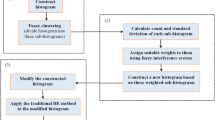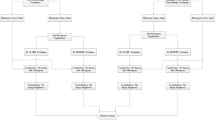Abstract
Contrast enhancement methods are used to reduce image noise and increase the contrast of structures of interest. In medical images where the distinction between normal and abnormal tissue is subtle, accurate interpretation may become difficult if noise levels are relatively high. To provide accurate interpretation and clearer image for the observer with reduced noise levels “a novel adaptive fuzzy gray level difference histogram equalization algorithm” is proposed. At first, gray level difference of an input image is calculated using the binary similar patterns. Then, the gray level differences are fuzzified in order to deal the uncertainties present in the input image. Following the fuzzification, fuzzy gray level difference clip limit is computed to control the insignificant contrast enhancement. Finally, a fuzzy clipped histogram is equalized to obtain the contrast-enhanced MR medical image. The proposed algorithm is analysed both visually and analytically to calculate its performance against the other existing algorithms. Visual and analytical results on various test images affirm that the proposed algorithm outperforms all other existing algorithms and provide a clear path to analyse the fine details and infected portions effectively.






Similar content being viewed by others
References
R. C. Gonzalez and R. E. Woods, “Digital Image Processing”, Addison-Wesley,1993.
Kim, Yeong-Taeg, Contrast enhancement using brightness preserving bi histogram Equalization, IEEE Trans. Consum. Electron. 43(1) (1997) 1-8.
Ooi, Chen Hee, Nicholas Sia Pik Kong, and Haidi Ibrahim, Bi-histogram equalization with a plateau limit for digital image enhancement, IEEE Trans. Consum. Electron. 55(4) (2009) 2072-2080.
Y. Wang, B. Zhang, Image enhancement based on equal area dualistic sub image histogram equalization method, IEEE Trans. Consum. Electron. 45 (1) (1999) 68–75.
S. Chen, R. Ramli, Minimum mean brightness error bi-histogram equalization in contrast Enhancement, IEEE Trans Consum. Electron. 49 (4) (2003) 1310–1319.
Abdullah-Al-Wadud M, Ali Akber Dewan M, Hasanul Kabir M, Chae O, A dynamic histogram equalization for image contrast enhancement, IEEE Trans. Consum. Electron. 53 (2) (2007) 593–600.
S. D. Chen, R. Ramli, Contrast enhancement using recursive mean-separate histogram equalization for scalable brightness preservation, IEEE Trans. Consum. Electron. 49 (4) (2003) 1301–1309.
H. Ibrahim, N. Kong, Brightness preserving dynamic histogram equalization for image contrast enhancement, IEEE Trans. Consum. Electron. 53 (4) (2007) 1752–1758.
N. Sengee, H. Choi, Brightness preserving weight clustering histogram equalization, IEEE Trans. Consum. Electron. 54 (3) (2008) 1329–1337.
Magudeeswaran Veluchamy, Krishnamurthy Mayathevar, Bharath Subramani, Brightness preserving optimized weighted bi-histogram equalization algorithm and its application to MR brain image segmentation, Int. J. Imaging Syst. Technol., 29 (3) (2019) 339-352.
Y. Yang, Z. Su and L. Sun, Medical image enhancement algorithm based on wavelet transform, Electron. Lett., 46 (2) (2010) 120 – 121.
S. Jeevakala, A. Brintha Therese, Sharpening enhancement technique for MR images to enhance the segmentation, Biomed. Signal Proc. Control. 41 (2018) 21–30.
Iza Sazanita Isa, Siti Noraini Sulaiman, Muzaimi Mustapha, Noor Khairiah Karim, Automatic contrast enhancement of brain MR images using Average Intensity Replacement based on Adaptive Histogram Equalization (AIR-AHE), Biocybern. Biomed. Eng., (2016), https://doi.org/10.1016/j.bbe.2016.12.003.
Fathi Kallel, Ahmed Ben Hamida, A new adaptive gamma correction based algorithm using DWT-SVD for non-contrast CT image enhancement, IEEE Tran. Nano Biosci., (2017), https://doi.org/10.1109/TNB.2017.2771350.
P. Borusewicza, E. Stanczykb, K. Kubiaka, J. Spuzaka, K. Glinska-Suchockaa, M. Jankowskia, J. Nicponb, P. Podgórskid, Liver enhancement in healthy dogs after gadoxetic acid administration during dynamic contrast-enhanced magnetic resonance imaging, Vet. J., 235 (2018) 16–21.
Leonardo Rundo, Andrea Tangherloni, Marco S. Nobile, Carmelo Militello, Daniela Besozzi, Giancarlo Mauri, Paolo Cazzaniga, MedGA: A novel evolutionary method for image enhancement in medical imaging systems, Expert Syst. Appl. (2018), https://doi.org/10.1016/j.eswa.2018.11.013.
V. Anoop & P. R. Bipin, Medical Image Enhancement by a Bilateral Filter Usin Optimization Technique, J. Med. Syst. 43 (240) (2019), https://doi.org/10.1007/s10916-019-1370-x.
Navdeep Singh, Lakhwinder Kaur, Kuldeep Singh, Histogram equalization techniques for enhancement of low radiance retinal images for early detection of diabetic retinopathy, Eng. Sci. Technol., Int. J. 22 (2019) 736–745.
Chenyi Zhaoa, Zeqi Wanga, Huanyu Lia, Xiaoyang Wua, Shuang Qiaoa, Jianing Sunb,A new approach for medical image enhancement based onluminance-level modulation and gradient modulation, Biomed. Signal Proc. Control 48 (2019) 189–196.
B. Subrahmanyeswara Rao, Dynamic Histogram Equalization for contrast enhancement for digital images, Appl. Soft Comput. J., (2020), https://doi.org/10.1016/j.asoc.2020.106114.
Subramani, B., Veluchamy, M, A fast and effective method for enhancement of contrast resolution properties in medical images. Multimedia Tools Appl., (2020), https://doi.org/10.1007/s11042-019-08521-0.
Magudeeswaran Veluchamy, Bharath Subramani, Image contrast and color enhancement using adaptive gamma correction and histogram equalization, Optik, 183 (2019) 329-337.
Magudeeswaran Veluchamy, Bharath Subramani, Fuzzy dissimilarity color histogram equalization for contrast enhancement and color correction, Appl. Soft Comput. J., 89 (2020) 106077, https://doi.org/10.1016/j.asoc.2020.106077.
Kandhway, P., Bhandari, A. K., & Singh, A, A novel reformed histogram equalization based medical image contrast enhancement using krill herd optimization, Biomed. Signal Proc. Control, 56 (2019) 101677, https://doi.org/10.1016/j.bspc.2019.101677.
Author information
Authors and Affiliations
Corresponding author
Additional information
Publisher’s Note
Springer Nature remains neutral with regard to jurisdictional claims in published maps and institutional affiliations.
This article is part of the Topical Collection on Image & Signal Processing
Rights and permissions
About this article
Cite this article
Subramani, B., Veluchamy, M. Fuzzy Gray Level Difference Histogram Equalization for Medical Image Enhancement. J Med Syst 44, 103 (2020). https://doi.org/10.1007/s10916-020-01568-9
Received:
Accepted:
Published:
DOI: https://doi.org/10.1007/s10916-020-01568-9




